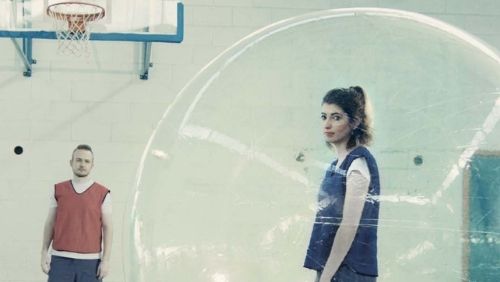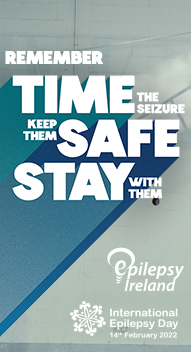
TIME – SAFE – STAY!
These are the three words we want you to remember from visiting this page. Why? Because these are the three crucial words to remember when it comes to responding to a seizure.
TIME – The first thing you should do is TIME the seizure. This is because if a seizure goes over 5 minutes, an ambulance should be called.
SAFE – Keep the person SAFE during the seizure. If a person is having a convulsive seizure, cushion their head with something soft if possible and remove any harmful objects, e.g. furniture from their vicinity. NEVER put anything in a person's mouth or restrain them during a seizure. These are myths when it comes to seizure first aid! Be aware that there are also types of seizures where the person does not experience convulsions. Instead they may “zone out” or stare blankly, become confused or agitated, display behaviours like chewing, smacking their lips, fiddling with their clothes or wandering aimlessly. In this type of seizure, the person’s awareness of their surroundings is affected and it is important to gently guide the person away from any danger. As with convulsive seizures, never restrict the person’s movements.
STAY – After the seizure passes, STAY with the person. Often after a seizure, a person with epilepsy will be dazed, confused and in many cases, exhausted. Make sure to stay with them, talk gently to them, and let them know everything will be okay. During the seizure and after it passes, STAY with the person. Typically, when a seizure ends, a person with epilepsy will be confused, often exhausted and may have experienced an injury if they have fallen. Stay with them until recovery is complete, calmly reassure the person, explain what has happened and ensure normal first aid steps are taken if there has been an injury.
TIME – SAFE – STAY. You now know how to respond to a seizure thanks to these three key words and thank you for visiting our page on this – but wait, there’s more! Keep scrolling to learn more about epilepsy and Epilepsy Ireland’s International Epilepsy Day 2022 campaign.
What is epilepsy?
Simply put, epilepsy is a tendency to have repeated seizures. Seizures are bursts of electrical activity in the brain that temporarily interfere with how the brain works. Seizures can be compared to a computer crashing and rebooting – which is something most of us will have experience of! Just before your computer crashes, it might start to run a bit slow or behave differently. Suddenly, the screen goes blank, or we get the dreaded blue circle of doom on our screens. But, usually after a few minutes, your computer comes back on. However, it takes time for the computer to get things running as before but with time and care, you get there. This is very similar to what’s happening in a person’s brain before, during & after a seizure. You can learn more about the different types of seizures by visiting the information resource on our website.
Why is it important to know seizure first aid?
People are often surprised to find out just how common epilepsy is. There are over 40,000 people living with the condition in Ireland. The chances are that some of these 40,000 people are your neighbours, colleagues and friends. We’re sure they would appreciate you knowing what to do should they have a seizure when they’re with you. We also have detailed seizure first aid posters which you can download and share with family and friends.
Other than after 5 minutes, is there any other instance where I should call an ambulance for a seizure?
There are! We’ve listed these below:
- If it’s a person’s first seizure or if you don’t know whether the person has epilepsy or not (often a person with epilepsy may have something within their wallet or a medical ID bracelet identifying they have epilepsy).
- If a person is physically injured during a seizure e.g. from falling, they might need to visit A&E.
- If a person briefly comes out of a seizure and goes into another one.
- If the person is pregnant.
FINALLY, and most importantly, if you’re in any doubt about the person’s wellbeing, call emergency services and explain what has happened. It’s always better to be safe than sorry.
Is there anything else I need to know about epilepsy?
Well, first of all, knowing TIME – SAFE – STAY is a good start. If you’re not personally familiar with epilepsy, it’s perfectly understandable that you might not know much about it. But seeing as we have your attention, why not take a few minutes to find out a bit more. We suggest visiting our pages on Epilepsy Explained and Epilepsy Myths and Misunderstandings - they will give you a wider insight into the condition.
We often describe a diagnosis of epilepsy as a “journey” as it is an extremely individual condition. No person’s journey is the same. The type of seizures they have; the approach taken with treatment; side-effects from medications; and what triggers their seizures can all be different from person to person. Up to 70% of people will go on to become seizure-free when the right treatment route is identified for them – but this can be very much trial & error and take considerable time. For the other 30%, seizures will remain a part of their lives due and can be the cause of significant, often hidden, disability.
All of this can be challenging for a person with epilepsy – especially when there is still sometimes a misunderstanding about their abilities in terms of being able to work, pursue further education or take part in social or sporting activities. Remember the video and images that may have got you here? This can sometimes lead to a person with epilepsy not discussing their condition due to fear of being stigmatised.
In general, epilepsy is not a condition that prevents people from living their lives to the full, even if some precautions and adjustments need to be taken.
By visiting this page, you have taken direct action to better understand this very common condition. This is key to increasing public understanding of epilepsy. Please follow our social media channels and you will learn more throughout the year about epilepsy and don’t forget to have a wander around our website to find out even more.
About our Campaign…
Our campaign for International Epilepsy Day 2022 was fronted by three wonderful Epilepsy Ireland Volunteers who are very passionate about raising awareness of epilepsy. Lucy Prevo (Bubble Girl), Wayne O’Reilly (Sir Wayne of Wexford) and Lisa Whelan (Bubble-WRAP girl) put themselves out there in the public eye to help inform the public on seizure first aid.
Our campaign aimed to highlight that while we all want to help when someone has a seizure, seizures often happen suddenly and unexpectedly and even with the best placed intentions, sometimes people can go about it the wrong way. Sometimes, it can be the case that people with epilepsy are over-protected by society to minimise the risks if a seizure was to occur, often out of not knowing what to actually do if that was to happen.
It really doesn’t have to be as difficult as encasing someone in a bubble, making them wear a suit of armour or wrapping them up in bubble wrap!
There is an easier way, just remember TIME – SAFE – STAY!
